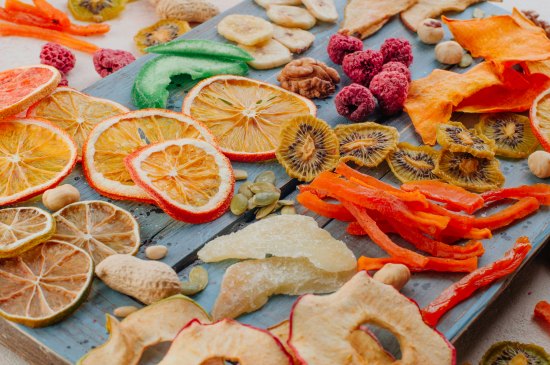Since we are all experiencing a shortage of canning jars, we should all brush up on our dehydration skills, just in case all those tips to find jars still turns up nothing.
Dehydrating is one of the most economic ways of storing long-term food supplies. Best of all, when you grow your own food sources, you get even more out of the investment.
The dehydration process essentially removes the moisture from foods to preserve them for much longer. Everyone is familiar with jerky (see our recipe here), which is simply dehydrated meat, but because of the nationwide canning jar shortage, dehydration could be the next best thing! Best of all, it’s a way to frugally stock up the pantry and uses fresh food. Best of all, the dehydration process does not diminish the quality or nutritional content of the food.
Get more dehydrating recipes with our best-selling Prepper’s Cookbook.
Choosing a Dehydrator
We have a LEM dehydrator (and meat grinder, and pressure canner) because we like the brand. The products are reasonably priced and have not had any quality concerns with any of the products. You can et a dehydrator in almost any brand you would like on Amazon, or you can go straight to LEM’s website. (Last I checked, pressure canners are on backorder, but the dehydrators were in stock). If you want to try dehydration foods in lieu of canning this year, consider which dehydrator you would like.
The Excalibur: Food Dehydrating Made Easy {Plus Tasty Recipes}
Prepping on a Budget: 4 Food Dehydrators under $75
There are two types of dehydrators:
1. Vertical Flow Food Dehydrators – these are also sometimes called stackable unit food dehydrators. They have a heat source that’s located either at the base of the food processor or at the top. Vertical flow food dehydrators tend to be the most affordable options, but that’s in part because they don’t spread heat as uniformly. If you are vegan, this may be a great option for you because they work well enough for most vegetables and fruits, but you’ll have a harder time getting good meat jerky out of them.
2. Horizontal Flow Food Dehydrators – these are sometimes referred to as shelf tray food dehydrators and work a bit more like a conventional oven, with the heating source located in the back. They’re more expensive than vertical models but are known for dehydrating at a more even rate throughout the device. This makes them the ideal choice for making beef jerky and dehydrating meat. They are also a bit bigger than vertical flow dehydrators, so you will need more storage space and counter space to use these.
Take the time to consider the price, airflow, your space, and whether or not you intend to dehydrate meat. I also recommend reading the reviews on a site like Amazon (even if you don’t purchase from them.) Read all the best-rated reviews and all of the worst-rated reviews so you get some awareness of what to expect.
Once you have purchased your dehydrator, break it out and use it! Practice, follow the instructions, and try simple vegetables or fruits first! Once you have dehydrated food, the goal would be to store that food.
Storage of Dehydrated Foods
Store dehydrated foods in a cool, dry, dark place, like a root cellar. The whole point of dehydrating food is to remove as much moisture as possible so that the food can be safely stored without it spoiling, so the last thing you want to do is re-introduce moisture during the storage process! Even when properly dried and sealed, the temperature will still affect the shelf life of your food. For example, food stored at 60F has twice the shelf life as food stored at 80F. Oxidation (the introduction of oxygen to your food) will cause your food to break down, lose flavor, and shorten the shelf life. Like oxygen, the light will also break down the food and cause off-flavors, loss of nutrients, and shorten the shelf life.
6 Rules You Need To Follow When Dehydrating Foods
Make sure your food is in an airtight container. Properly dried food can be stored in an airtight glass or hard plastic container that has an airtight seal, such as canning jars. Since those are in short supply right now, maybe vacuum sealing is the better option right now.
Vacuum Sealing: This method is good for longer-term storage. The process removes all the oxygen from the container to extend the shelf life of the food.
If you dehydrate vegetables, you can later toss them in a soup or stew and they will soak up the liquid and rehydrate. You could also, obviously just eat the dehydrated foods.
Dehydrating can also be used to make your own spice. When the polar vortex of early September rolled through our area and ruined our garden (upsetting, but we were moderately prepared) we were able to salvage some of the vegetables, such as our jalapeno peppers.
We had too many to use before they were going to go bad, so we smoked them in our smoker, then dehydrated them, then ground them into a spice. Wear glasses (any glasses will do, such as blue light or sunglasses), and avoid touching your face or eyes while doing this. This jalapeno pepper powder gives food an immediate kick of spice and adds a little flavor. A dehydrator can help you save foods you have to harvest early to avoid losing them! Another quick tip if you want to make your own pepper spice: get a separate grinder. Jalapeno spice power is awesome, but not in your coffee!
Use your imagination! There are so many things you could dehydrate to store in a prepper pantry or provide as snacks or just for meals in general!
This article was originally published at Ready Nutrition™ on November 1st, 2020







